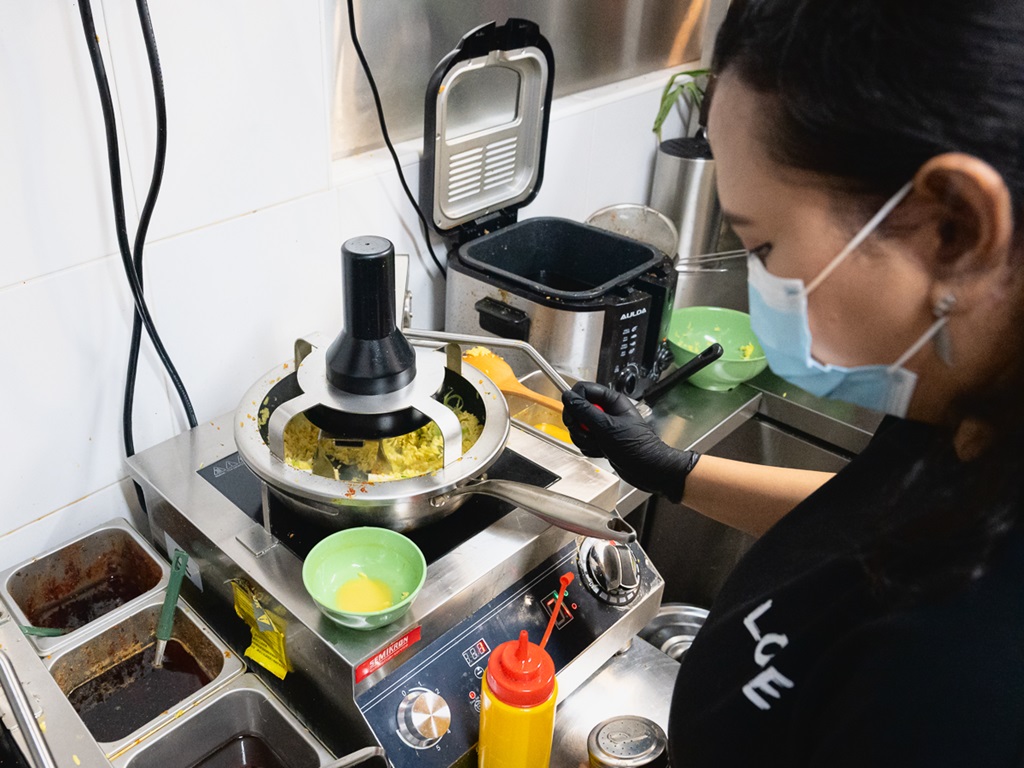Hawker Hustlers: M+ Fried Rice Paradise’s Nam turns out plates of fried rice with a little help from some tech

Hawker Hustlers is a HungryGoWhere series spotlighting young and emerging hawkers with compelling stories. Read through all the way for an exclusive GrabFood promo so you can try their food, too.
- A former lab tech and self-taught cook, Siti Nurnameera, 26, is the first-time hawkerpreneur-owner of M+ Fried Rice Paradise
- With the help of a high-tech automated cooker, she has created a menu with unique fried rice flavours such as curry, sambal and hae bee hiam.
- She has also tapped the advice of older hawkers on streamlining processes and strives to keep her brand fresh by adding new menu items.
Singapore is literally a fried rice paradise, with many hawker stalls and zi char restaurants selling the quintessential dish. The newly opened M+ Fried Rice Paradise, situated at Woodleigh Village Hawker Centre, is the latest entrant to the scene.
Owner Siti Nurnameera Abdul Samad (who goes by the nickname Nam) is all about putting an interesting twist on her fried rice dishes.
The 26 year-old has crafted a “Malay-fusion” spin on Chinese-style egg fried rice. Here, you’ll find your usual plate of comforting egg fried rice, but there are also fried rice flavours such as hae bee hiam, sambal and curry.

These come paired with different proteins such as sakura shrimp, salmon, salted chicken and beef.
Something else which stands out is her deft use of technology. If you sneak a peek into her stall, you’ll spot a grey automated cooker, which helps her turn out plates quickly, without compromising on flavour.
Nam’s hawker journey
Unlike many hawkers, Nam is entirely self-taught. Before opening M+ Fried Rice in September, she’d always thought of cooking as more of a hobby.
“I would cook random dishes I felt like eating and research recipes online, such as kimchi fried rice,” she says.
She has made quite the career switch too, having previously worked as a lab technician at Republic Polytechnic, before making the transition to the hawker life.
Even without prior culinary experience, Nam’s passion for food propelled her to open her own stall.
“I always aspired to start my own food business. It was more a question of whether I would launch it now, or further down the line,” she adds.
Ultimately, Nam decided that sooner was better than later, especially when the opportunity came to open a stall at Woodleigh Village Hawker Centre.
She’d also decided on a hawker business — as opposed to a cafe — so that her food would appeal to a wider demographic, including older patrons and young parents with children.
As a first-time hawker, she’s also thankful that her parents approved of her bold venture.
“They were initially worried about the tiring nature of the work and me coming home late at night, but were still very supportive and even helped taste-test my rice when I was experimenting,” she says.
Cooking with high-tech gear
As Nam recalls, she started tinkering with the idea of a fried rice stall about a year ago.
“I wanted to make inclusive halal food for all, and chose fried rice as it’s such a versatile comfort dish,” she says. “I then begin trying out various recipes and testing out different proteins.”
Her original approach was to cook rice in a traditional wok. However, plans changed when she met a Hong Kong-based zi char chef. He suggested using his automated cooker to mix the ingredients thoroughly and cook the rice — the rest is history.

“Some people might say we are taking the easy way out by using tech, rather than a wok, but we still achieve that wok hei flavour from the machine,” she says.
The cooker has two rotating rotas, which stir the rice in a constant figure-eight motion, so that the heat is evenly distributed throughout the rice and its ingredients. It’s also configured for a picture-perfect finish in around two minutes, as opposed to five, if using a wok.
Nam says the machine’s high heat is also instrumental for that must-have tinge of wok hei.

Although Nam was quick to embrace the technology, it did take a while for her to master it.
“The first time I used it, I actually burnt a pot and a pan,” she says, laughing. “I didn’t realise that the induction made the equipment heat up really fast, so both utensils were completely charred at the bottom!”
When she finally got the hang of the device, she next spent time on perfecting the fried rice recipe, especially the ratio of rice and seasoning across the various types of fried rice.
For example, it was trial and error to figure out how much spice was enough for the sambal fried rice, or in adjusting the flavour of the curry paste so it wasn’t too bland or overwhelming.
M+ Fried Rice Paradise’s menu
Nam best describes her menu as Chinese-style fried rice paired with Malay flavours. In essence, a Malay-Chinese fusion approach.
First, pick your fried-rice flavours, which come in four options.
M+’s Chinese influence is reflected in dishes such as the egg fried rice (from S$3.20), as well as the hae bee hiam (spicy dried sambal) fried rice (from S$4.50).
If diners are craving something with a more spicy kick, they can pick from Malay-infused flavours such as the sambal fried rice (from S$4) and curry fried rice (from S$4.50).
Next, diners can also pick different proteins to go along with their fried rice flavours, such as fried chicken, shrimp, beef and salmon.
This gives you options galore. Some possible plates that caught our eye included the hae bee hiam chicken fried rice (S$6), curry salmon fried rice (S$8.30), as well as the sambal sakura shrimp fried rice (S$8).

We had a chance to try all these variations, starting with the signature hae bee hiam chicken fried rice. We liked how the dish put a different spin on your traditional fried rice — Nam tells us that the secret hae bee hiam sauce is made from scratch, with a combination of dried shrimp, various spices and chilli for that added kick.
I found the fried chicken quite addictive too, with nice, crispy skin and juicy meat.

Next up was the curry salmon fried rice. When experimenting with flavours, Nam found that the smoky taste of the salmon added an elevated touch to the curry-infused rice. The curry paste is also made in-house.
It appears Nam’s R&D efforts have succeeded — the curry flavour was well-balanced.. Curry lovers will get that spicy kick they desire, while the salmon adds a nice, mellow contrast to flavourful carb base.

Of course, we also had to try the classic egg fried rice (S$3.20). Nam observes that this is one of her most popular dishes for patrons who want something quick, simple and affordable — especially older customers and parents with kids.
Our thoughts? Whilst you could certainly taste the wok hei flavour, it didn’t come out as strong as compared to hawker offerings at places such as Chef Wang Fried Rice..
I did feel the rice grains were a tad dry, as well — perhaps it’s the type of rice used, or slight overfrying.
Nevertheless, this dish will still remain a crowd-pleaser for hawker-goers looking for an affordable and fuss-free option.
Forging ahead as a young hawker
Despite being a young hawker with no prior experience, Nam is coping well with the transition.
“The biggest change would be the longer work hours. But my previous job was also quite physical as I’d helped prepare lessons and equipment for lab experiments, so I’m used to manual work,” she says.
When she worked at the lab, Nam would weigh out chemicals in preparation for lab experiments. Today, she works with ingredients instead — although she’s following recipes that she’s put together on her own.
Nam added that when the stall first opened, the team was inefficient in certain processes. Closing for the evening was one such example. In fact, they took over two hours just to clean up the stall and left at almost midnight each day for the first week — long after M+’s intended closing time of 9.30pm.
“Thankfully, we tapped the helpful advice of older hawkers in the surrounding stalls, who suggested moving our equipment out so we could clean our floors and surfaces faster,” she says. “It seemed like such a simple thing to do, but we were so tired that it didn’t come to mind!”
Looking ahead, Nam hopes to continue innovating and making her business a successful one. Since last month, she has added nasi lemak (from S$4 for a set) to her menu, to offer more options for the breakfast crowd. The standard set includes a chicken drumstick, egg, sambal and pandan rice, with add-ons like har cheong wings (S$2) and fish fillet (S$1.20).
In future, she’s even considering branching out to selling other kinds of cuisines, or launching her nasi lemak as a standalone brand.
“I might even do a noodle-focused brand, maybe we could call it M+ Noodles,” she jokes.
Exclusive GrabFood promo
Good news for our readers who scrolled all the way to the end! Here’s your exclusive GrabFood delivery promo for M+ Fried Rice Paradise – Woodleigh Village Hawker Center, valid from Nov 10 to Dec 10, 2024.
How it works:
- Use the promo code HGWMFRP for S$3 off your basket (minimum spend of S$15) when you order from M+ Fried Rice Paradise – Woodleigh Village Hawker Center.
- Stackable with free M+ Fried Rice Paradise delivery (up to S$3 off) with a GrabUnlimited subscription.
- While redemptions last, capped at one redemption per person.
For more places to explore, check out our latest articles on this HK milk tea brand that’s new to Singapore, as well as our compilation of places to explore around Ion Orchard.
M+ Fried Rice Paradise is on the GrabFood delivery service and offers free delivery (up to S$3 off with GrabUnlimited).
Enjoy up to 50% off when you dine with GrabFood Dine Out.
You can also book a ride to M+ Fried Rice Paradise at Woodleigh Village Hawker Centre.
M+ Fried Rice Paradise
Woodleigh Village Hawker Centre, 01-11, 202C Woodleigh Link
Nearest MRT: Woodleigh
Open: Wednesdays to Mondays (8:45am to 9:30pm). Closed Tuesdays.
Woodleigh Village Hawker Centre, 01-11, 202C Woodleigh Link
Nearest MRT: Woodleigh
Open: Wednesdays to Mondays (8:45am to 9:30pm). Closed Tuesdays.







